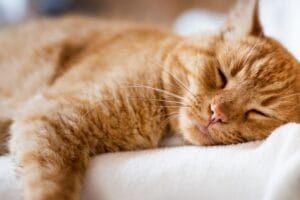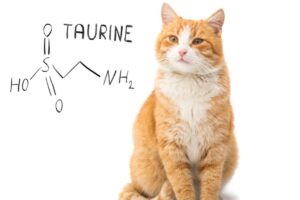Foods Cats Eat From the Fridge: 8 Items Your Pet Would Love!
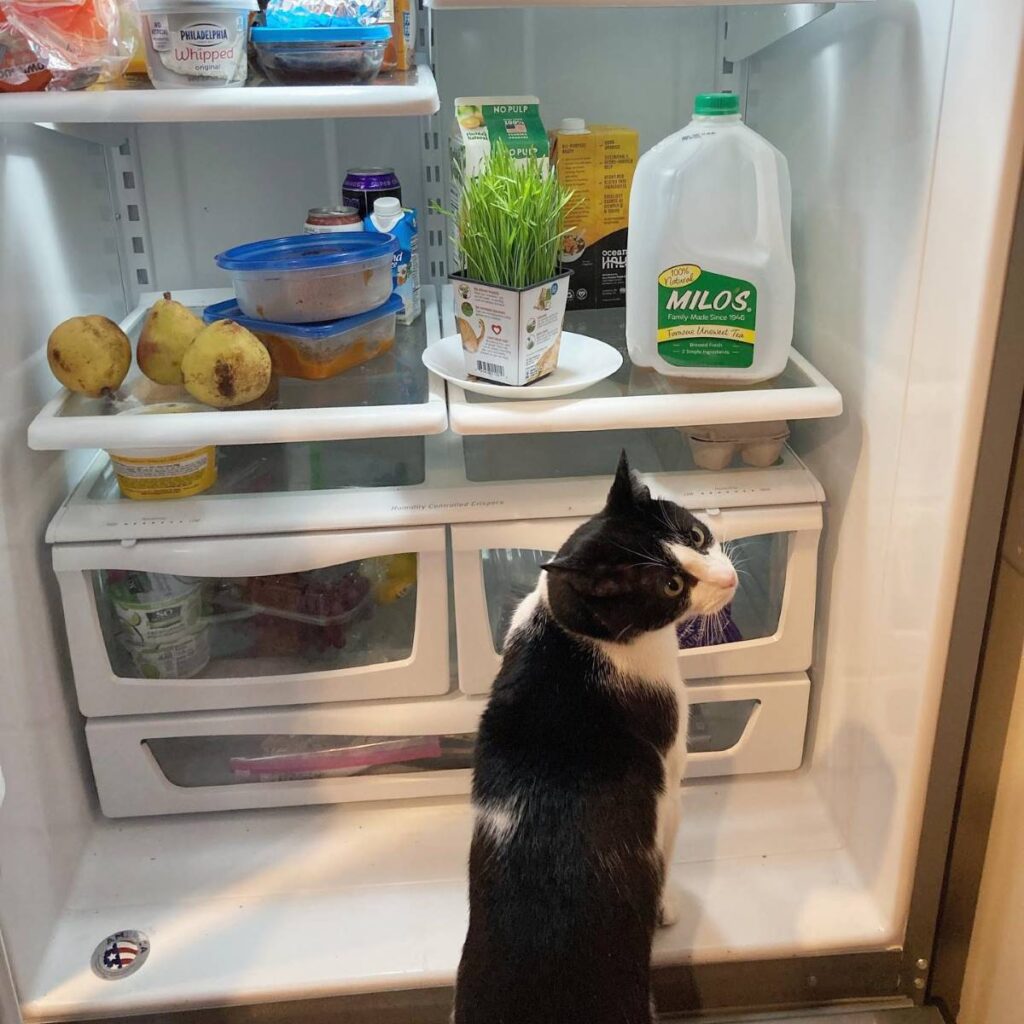
As cat owners, we want to provide our feline pets with a variety of tasty and nutritious foods. While some may think that cat food is limited to dry kibble or canned options, there are actually several foods cats eat from the fridge and are beneficial for them. In this article, we’ll explore eight fridge items that your cat would adore. From vegetables to eggs, ground beef to fish, and even rice, these options will not only please your pet’s taste buds but also provide essential nutrients.
Foods Cats Can Eat From the Fridge: Exploring the Advantages and Disadvantages
Feeding our pet cat, foods from the fridge can offer both advantages and disadvantages. While it introduces variety to their diet and provides additional nutrients, it is crucial to understand the potential risks associated with certain fridge items. Let’s delve deeper into the advantages and disadvantages of feeding fridge foods to cats.
Advantages:
- Nutritional Variety: Offering foods from the fridge expands the range of nutrients your cat receives. Different food items such as vegetables, eggs, and fish provide a diverse array of vitamins, minerals, and essential fatty acids.
- Palatability: Fridge foods can be highly palatable to cats, enticing even the pickiest eaters. The different textures, flavors, and aromas of cooked vegetables, meats, and fish can make mealtime more enjoyable for your feline friend.
- Added Hydration: Certain fridge foods, like cooked vegetables and fish, contain higher moisture content than dry kibble. This can contribute to your cat’s overall hydration, particularly if they don’t drink much water.
Disadvantages:
- Food Safety: While many fridge foods are safe for cats, it’s essential to handle and store them properly to prevent bacterial contamination. Raw or undercooked meats, such as ground beef and liver, pose a higher risk of bacterial infection. Thoroughly cook all meats to eliminate this risk.
- Allergies and Sensitivities: Cats, like humans, can have food allergies or sensitivities. Some fridge items, such as eggs or certain vegetables, may trigger adverse reactions in sensitive individuals. Monitor your cat for any signs of allergies, such as vomiting, diarrhea, or skin irritations, and consult with a veterinarian if you have concerns.
- Imbalanced Diets: Feeding fridge foods alone may lead to an imbalanced diet if not appropriately supplemented with other essential nutrients. While these foods offer various benefits, they should complement a balanced and complete feline diet.
Incorporating fridge foods into your cat’s diet can provide nutritional variety and enhance mealtime enjoyment. However, it is crucial to ensure proper food safety, be aware of potential allergens, and maintain a balanced overall diet. Consulting with a veterinarian is always recommended to determine the best approach for your cat’s specific dietary needs and to address any concerns you may have. By understanding the advantages and disadvantages, you can make informed decisions when feeding fridge foods to your feline companion.
Food Item 1: Raw Vegetables

Raw vegetables can be a surprising delight for cats. Not only do they add a crunchy texture to their meals, but they also offer a range of vitamins, minerals, and fiber. Some cat-friendly options include thinly sliced cucumbers, baby carrots, and snap peas.
Raw vegetables provide a refreshing and natural snack that can contribute to a balanced feline diet. However, it’s important to note that not all vegetables are safe for cats. Avoid feeding onions, garlic, and other toxic vegetables to your feline friend. Additionally, always wash and prepare the raw vegetables properly before offering them to your cat.
While some cats may not take an immediate liking to raw vegetables, gradually introducing them as part of their diet can help in developing a taste for these healthy treats. Keep in mind that each cat is unique, and their preferences may vary. If your cat shows no interest in raw vegetables, you can try lightly steaming them to make them more enticing.
As with any new food, monitor your cat for any adverse reactions, and consult with a veterinarian if you have any concerns. Adding raw vegetables to your cat’s diet can provide nutritional benefits and enrich their culinary experience.
Food Item 2: Cooked Eggs

Cooked eggs are a fantastic source of high-quality protein for cats. Whether hard-boiled or scrambled, they provide essential nutrients that cats can benefit from. It’s important to ensure that the eggs are fully cooked and the shell is removed before serving.
Hard-boiled eggs are an easy and popular choice. Simply place the eggs in a saucepan, cover them with water, and simmer for 8-10 minutes. Once cooked, let them cool before offering them to your cat.
Scrambled eggs are another delicious option. Whisk a few eggs in a bowl, heat a non-stick pan over low heat, and gently scramble the eggs until they are cooked through but still moist. Allow them to cool before serving.
Cooked eggs offer easily digestible protein and essential nutrients. They contain amino acids necessary for muscle development and vitamins such as A, D, and B-complex vitamins for a healthy coat, strong bones, and a robust immune system.
However, it’s important to feed cooked eggs in moderation as part of a balanced diet. They should supplement regular meals rather than replace them. Consult with your veterinarian to ensure the appropriate portion sizes and dietary requirements for your cat.
Remember to always prioritize your cat’s safety and consult with a veterinarian before making any significant changes to their diet. Cooked eggs can be a nutritious and enjoyable addition to their meals, promoting their overall health and happiness.
Food Item 3: Ground Beef

Ground beef is a delectable and protein-rich option that cats simply adore. It can be prepared in various ways and served plain or mixed with other ingredients to enhance its flavor. When choosing ground beef for your feline friend, it is essential to opt for lean cuts that are low in fat.
Before feeding ground beef to your cat, it is crucial to ensure that it is fully cooked. Cooking ground beef thoroughly helps eliminate any potential bacteria that may pose a risk to your cat’s health. Properly cooked ground beef also makes it easier for cats to digest and prevents any digestive discomfort.
Ground beef provides essential amino acids that are necessary for your cat’s overall health and well-being. It is a rich source of protein, which is crucial for muscle development and repair. Additionally, it contains vital nutrients such as iron, zinc, and B vitamins, which support a healthy immune system and promote optimal metabolic function.
While ground beef can be a tasty and nutritious addition to your cat’s diet, it should be offered in moderation. Excessive consumption of ground beef or any other protein source can disrupt the balance of nutrients in your cat’s diet. It is important to consult with your veterinarian to determine the appropriate portion sizes and ensure a well-rounded and balanced diet for your feline companion.
By incorporating lean and properly cooked ground beef into your cat’s meals, you can provide them with a savory and nutrient-dense food item that adds variety to their diet and contributes to their overall health and happiness.
Food Item 4: Chicken Liver

Chicken liver is a highly nutritious and palatable food that often delights the taste buds of cats. Packed with essential vitamins and minerals, it offers numerous health benefits. However, it’s important to exercise moderation when feeding liver to your feline friend due to its high vitamin A content.
Chicken liver is a fantastic source of vitamin A, which plays a crucial role in maintaining your cat’s vision, promoting a healthy immune system, and supporting growth and development. It also provides other essential nutrients like iron, folate, and B vitamins, which contribute to overall feline health.
While chicken liver offers significant nutritional value, it should be fed in moderation. Excessive consumption of liver, particularly in large quantities or on a regular basis, can lead to an overdose of vitamin A. This can potentially cause vitamin A toxicity, which can have adverse effects on your cat’s health.
To include chicken liver in your cat’s diet, offer it as an occasional treat rather than a staple food. Consider providing small, bite-sized portions of cooked chicken liver to avoid overwhelming your cat’s system with an excessive amount of vitamin A. It’s also important to ensure that the liver is properly cooked to eliminate any potential pathogens.
By offering chicken liver in moderation, you can provide your cat with a nutrient-dense and delicious treat that supports their overall well-being without risking vitamin A toxicity. As with any dietary changes, it’s advisable to consult with your veterinarian to determine the appropriate frequency and portion size of chicken liver for your individual cat.
Food Item 5: Beef Liver
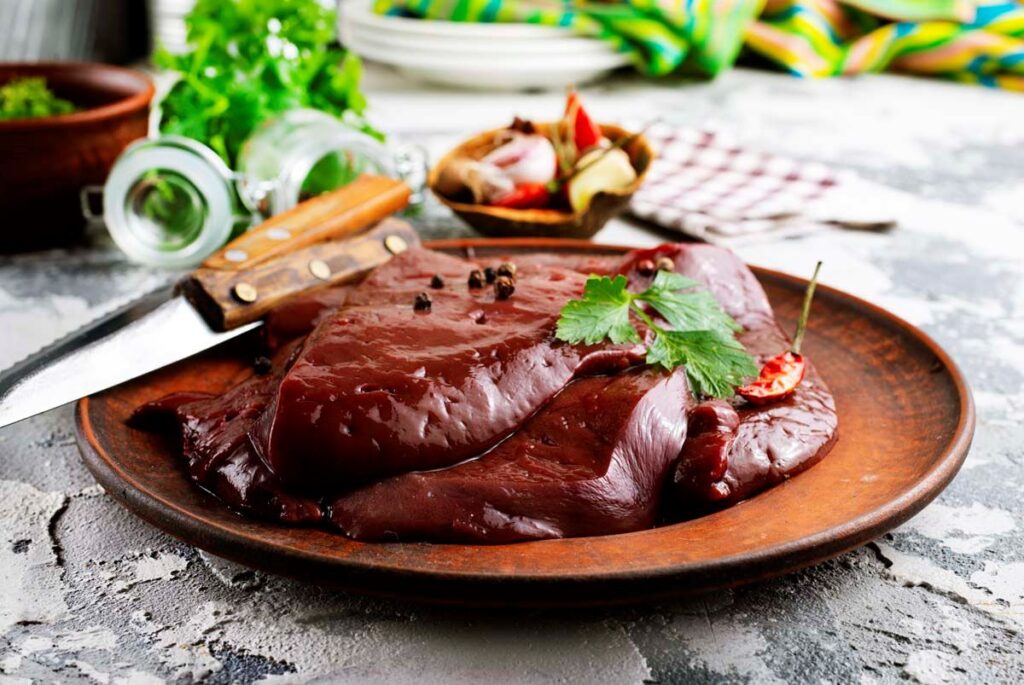
Beef liver is a highly nutritious food that provides cats with a wide array of essential nutrients. Just like chicken liver, it is rich in vitamins and minerals that support optimal feline health. Including beef liver in your cat’s diet can offer several benefits, but it’s crucial to prepare and serve it properly.
Beef liver is an excellent source of vitamins A, B12, and D, as well as iron and zinc. These nutrients play vital roles in maintaining a healthy coat, supporting immune function, and promoting overall well-being. The high iron content in beef liver also contributes to the production of red blood cells, which aids in delivering oxygen to the body’s tissues.
When incorporating beef liver into your cat’s meals, it’s essential to cook it thoroughly to ensure the elimination of any potential bacteria or parasites. Raw liver may pose a risk of bacterial contamination, so it’s best to err on the side of caution and cook it until it reaches a safe internal temperature. Once cooked, slice the beef liver into small, manageable portions for your cat’s convenience and ease of consumption.
As with any new food, it’s important to introduce beef liver gradually into your cat’s diet. Start with small amounts to gauge their tolerance and monitor for any adverse reactions. Additionally, remember to include beef liver as part of a balanced diet and not as the sole source of nutrition.
By including properly cooked beef liver in your cat’s diet, you can provide them with a nutrient-rich and delicious addition that supports their overall health. Consult with your veterinarian to determine the appropriate portion size and frequency of beef liver for your individual cat, taking into consideration their specific dietary needs and any underlying health conditions.
Food Item 6: White Fish
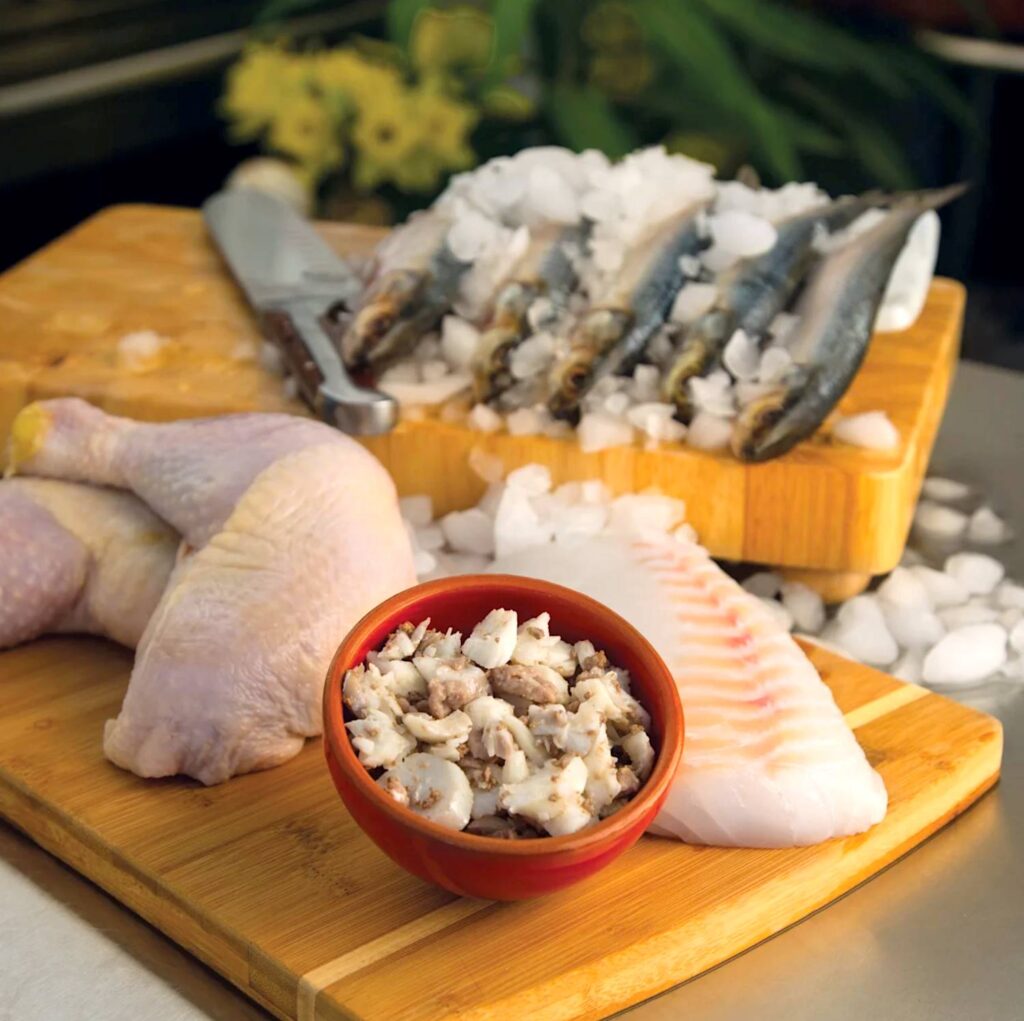
White fish, such as cod or haddock, is a highly beneficial food choice for cats due to its rich nutritional profile. It serves as an excellent source of lean protein, essential amino acids, and omega-3 fatty acids, which are essential for maintaining optimal feline health. Cats often find the delicate flavor and moist texture of white fish highly appealing, making it a popular addition to their diet.
When offering white fish to your cat, it is important to ensure that it is boneless, fully cooked, and free from any seasoning or added ingredients. Fish bones can pose a choking hazard and may cause injury to the digestive tract, so it is crucial to remove them before serving. Additionally, seasoning and added ingredients like salt, spices, or oils can be harmful to cats and should be avoided.
Cooking the white fish thoroughly not only eliminates any potential bacteria or parasites but also makes it easier for cats to digest. Overcooking, however, can deplete some of the beneficial nutrients, so it is best to cook the fish until it is opaque and flakes easily with a fork.
Introducing white fish to your cat’s diet can provide them with a lean protein source that supports muscle development and overall energy. The omega-3 fatty acids found in white fish contribute to healthy skin, a shiny coat, and support cognitive function. Remember to offer white fish in moderation as part of a balanced diet, taking into consideration your cat’s individual nutritional needs and any specific dietary requirements they may have.
As always, it is advisable to consult with your veterinarian before introducing any new food to your cat’s diet, including white fish. They can provide guidance on appropriate portion sizes, frequency, and any specific considerations based on your cat’s age, health status, and dietary preferences.
Food Item 7: Mackerel
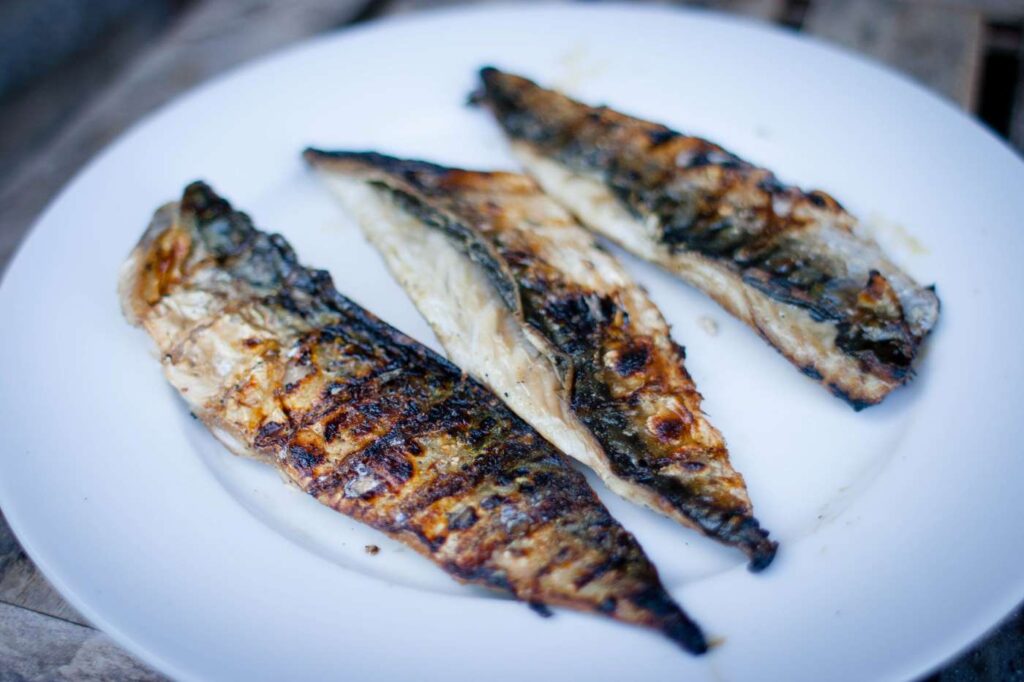
Mackerel is a highly nutritious and flavorful fish that many cats absolutely adore. Packed with omega-3 fatty acids, mackerel offers numerous health benefits for our feline friends. These essential fatty acids promote heart health, reduce inflammation, and contribute to a lustrous and shiny coat.
When including mackerel in your cat’s diet, it is crucial to choose boneless and fully cooked options. Fish bones can pose a choking hazard and may cause injury to the digestive tract, so it’s important to remove them before serving. Additionally, fully cooking the mackerel helps eliminate any potential bacteria or parasites that could be harmful to your cat.
One thing to note about mackerel is its strong flavor. While many cats are drawn to its distinctive taste, some may find it overpowering. It’s important to observe your cat’s preferences and offer mackerel as an occasional treat rather than a staple in their diet. This allows for variety and prevents them from becoming too reliant on one specific food item.
Introducing mackerel to your cat’s diet provides them with a wholesome source of protein, omega-3 fatty acids, and other essential nutrients. It can contribute to their overall well-being, support a healthy immune system, and enhance their coat’s appearance.
As with any new food, it’s advisable to consult with your veterinarian before introducing mackerel to your cat’s diet. They can provide personalized recommendations based on your cat’s specific nutritional needs, dietary restrictions, and any underlying health conditions.
Remember, moderation is key when feeding mackerel or any other food item to your cat. A balanced and varied diet, combined with regular veterinary care, will help ensure your cat remains healthy and happy for years to come.
Food Item 8: Rice

While cats are primarily carnivores, plain and properly cooked rice can be a beneficial addition to their diet. Rice can provide a source of carbohydrates and may be suitable for cats with sensitive stomachs. It is important to note that rice should not replace the essential animal-based protein in their diet but can be included as a complementary component.
Cooking rice for cats involves boiling it until it becomes soft and fully cooked. Avoid adding any seasonings, spices, or oils as these can be harmful to cats. Once the rice is cooked, allow it to cool before serving it to your feline friend.
Incorporating rice into your cat’s diet can have several advantages. Firstly, it can provide a source of energy, especially for active cats. The carbohydrates in rice can be converted into glucose, which serves as fuel for their body. Additionally, rice is gentle on the digestive system and can be beneficial for cats with sensitive stomachs or digestive issues.
However, it is crucial to offer rice in moderation. Too much rice in a cat’s diet can lead to an imbalance, as they primarily require animal-based protein. Rice should never replace the essential nutrients found in high-quality cat food.
When serving rice to your cat, consider mixing it with other cat-friendly ingredients such as cooked chicken or fish to enhance the flavor and nutritional value. This combination ensures that your cat receives a balanced meal that meets their dietary needs.
As with any new food item, it’s essential to monitor your cat’s reaction to rice. Some cats may have allergies or sensitivities to grains, so observe any signs of adverse reactions such as vomiting, diarrhea, or changes in behavior. If you notice any concerning symptoms, consult with your veterinarian for guidance.
Remember, rice should only be a small part of your cat’s overall diet. It is crucial to provide a well-balanced and species-appropriate diet that includes high-quality animal-based protein sources to meet their nutritional requirements.
Conclusion
Expanding your cat’s culinary options to include foods from the fridge can add variety to their diet and provide additional nutrients. Remember to introduce new foods gradually, monitor your cat’s response, and consult with your veterinarian for personalized advice. By offering cooked vegetables, eggs, ground beef, chicken liver, beef liver, white fish, mackerel, and rice, you can provide your feline companion with a range of flavors and essential nutrients they will love. Happy feeding!
